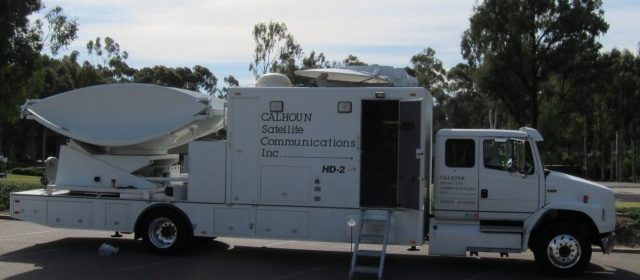Behind the Broadcast of Super Bowl XLV

If you didn’t know already, Super Bowl XLV is just a few more days away and FOX will be handling the broadcast honors this year. It’s not every day that I get to peek behind the scenes of the biggest broadcast event of the year so I jumped at the opportunity to meet Jeff Rozak of Calhoun Satellite Communications, Inc. and take a look inside his mobile uplink truck.
Jeff and his truck are going to be playing a critical role in bringing this Sunday’s Super Bowl XLV broadcast to your home by linking up Cowboys Stadium to FOX production facilities. Without further ado, let’s take a look at the uplink truck and get an overview of how the broadcast will make its way to your TV.
This particular mobile uplink has the capability of broadcasting up to 8 HD streams using a combination of fiber and satellite. The truck has two dishes, a 4.6 meter C-band dish and a 1.8 meter Ku-band dish. Last year’s broadcast used 2 fiber links and both the C and Ku-band links so we can probably expect something similar this year. The reason for so many links is to provide redundancy for such a critical broadcast.
A look inside the truck shows some of the patch panels, modulators, encoders, decoders, monitors, amps etc.


Before audio and video ever makes its way to the truck, it is first captured by all of the video cameras and microphones that are wired to mobile production trucks which will be run by FOX this year. The production trucks are typically responsible for choosing footage from the multitude of camera angles and microphones capturing the event. Just to give an idea of the scope of this endeavor, there will likely be about 12 production trucks in operation.
Once the raw audio and video feed has been produced, it will be piped into the Calhoun mobile uplink where it will be encoded at a very high bit rate and transmitted back to the main FOX production facility. FOX will make the determination of how much the bit rate will be and is responsible for ordering space segment. In addition to transmitting the broadcast, the rig may also receive a feed back from the main FOX production facility containing logos and graphics for insertion into the video feed by the production trucks. The connection between the mobile uplink and the mobile production trucks will be via this panel:

Once the main FOX production facility receives the feed, it will insert the national TV commercials and broadcast to all of the FOX affiliate stations. In turn, the affiliates will decode the content, introduce the local commercial spots, encode the new feed and transmit it out their broadcast towers. Cable companies will either receive the affiliate feed via the over-the-air broadcast or a direct fiber link to the affiliate and then multiplex the feed and transmit it direct to your home.

Now when you watch the Super Bowl this Sunday, you’ll have just a bit better insight into what is going on behind the scenes to make it happen. Stay tuned to MissingRemote as we hope to get some more details on the broadcast and hopefully some pictures of the production trucks in action at Cowboys Stadium. Oh and let’s see those Super Bowl predictions in the comments below!

Production costs must be
Production costs must be outrageous for all that equipment.
I have no personal interest in either team this year, but I have a feeling that Green Bay is going to win.